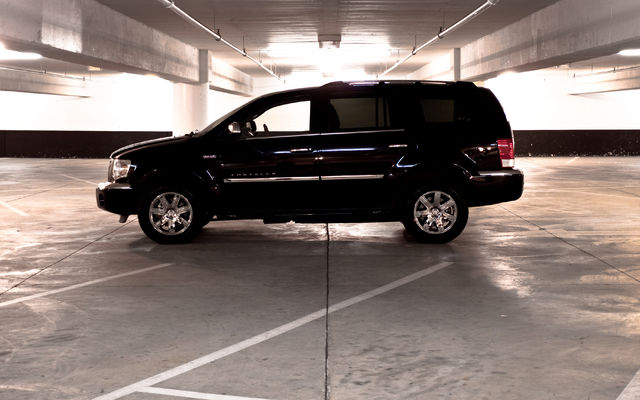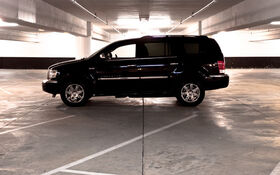2009 Chrysler Aspen Hybrid: The Best Vehicle You Didn't Know About.

| Strong points |
|
|---|---|
| Weak points |
|
Automotive manufacturer marketing teams are funny things. So often neglecting some of the most interesting vehicles in their own lineup (see: the Saturn Sky) in favour of more staid, regular performers, they toil away convincing you to buy a vehicle that you're probably already well aware of, while relative unknowns go gently into that good night that is showroom failure and eventual cancellation. The Chrysler Aspen Hybrid is one such vehicle. In fact, one could say that the Aspen Hybrid may just be the best vehicle you don't know about.
Having only recently stepped out of the impressive GMC Yukon Hybrid, I was eager to see how Chrysler's competitor would stack up. Having been blown away by the effectiveness of the GM 2-Mode system in its seamless operation and reduction in fuel consumption, the Aspen promised a wholly different experience from the first flick of the wrist. While the GMC surged to life with the hearty throb of its 6.0L V8, the Aspen did absolutely nothing. The familiar flicker of a multitude of trouble lights resetting themselves was the Aspen’s response to the startup procedure, before a glowing “Ready” appeared in the gauge cluster, signifying the vehicle's status. Selecting drive with the column-mounted shifter, the Aspen rolled out of the parking lot with nothing more than the high-pitched whine of electric motors straining against the laws of physics.
However, once motivated beyond parking lot speeds, the Chrysler’s hybrid system operated with much of the same seamless, unnoticeable precision of the recently tested GMC Yukon Hybrid. Igniting the 5.7L Hemi when conditions required was done with nearly identical smoothness, and the transmission’s ability to shift like a traditional automatic under load and hold the engine at a static speed like a CVT under lighter loads seemed very familiar; familiar enough to prompt further investigation. And surely enough, there it was, in clear and precise size 12 Arial typeface among Chrysler’s 2009 Aspen press package: “Offered in the Chrysler Aspen for the first time is Chrysler’s advanced, state-of-the-art two-mode full hybrid system, developed in partnership with General Motors, Mercedes-Benz and The BMW Group.” And while Chrysler’s system is obviously slightly tweaked for use in the Aspen, there’s far more similarities than there are differences between the two. Accelerating moderately up to highway speed elicits the same CVT-style engine operation that sees the Hemi sit at a single engine speed while the Aspen seemingly speeds up around it. Mat the throttle, and the engine kicks down and shifts like any other automatic-equipped vehicle. However, the Aspen’s 2-mode system seems to be slightly more aggressive in its electric operation; opting to shut off the engine sooner when rolling up to a stop. Likewise, the Aspen’s throttle lacks the immediate response of the Yukon’s, and the multi-displacement-equipped (which is in and of itself very similiar to GM's own cylinder deactivation technology seen in the Yukon Hybrid) 5.7L Hemi feels lazier than the quick 6.0L V8 in the GM. However, the trade off for that lazier nature is superior fuel economy, and the Aspen returned fuel mileage figures that were generally a tick or two below the Yukon's. However, staying committed to the throttle pedal rewards with deceptive acceleration from any speed. With a combined output of 385 horsepower and 401 pound-feet of torque, it gathers speed like a freight train so long as you keep the pedal depressed.
Sadly, it shares a certain freight-train like quality when you stomp on the brake pedal too. With soft suspension that deserves kudos for delivering a Cadillac-like magic carpet of a ride, the entire vehicle throws itself forward, and struggles to cease forward movement. Furthermore, utilizing the obligatory regenerative braking system that hybrid’s demand, the Aspen hybrid’s brake pedal is a spongy, rubbery mess. Granted, pedal effort increases in a linear fashion, but it always feels like something, somewhere between your right foot and the substantial calipers at all four corners, is bending.
However, that brake pedal may well be the only fly in this ointment. Inside, the Aspen boasts best-in-class interior room, and all three rows offer proper, adult-sized seating. With easy-to-use tumbling seats in the second row, your's truly managed to slide my 6’1” frame into the third row without any painful contortions. Loaded down with seven occupants for a lengthy trip out of town, not a complaint was heard from any of the seating positions, and the large, expansive windows in each seating position garnered many compliments from those enjoying the passing scenery. Equipped with quite comfortable couch-like seats that boast classy suede inserts, the Aspen’s interior is the most luxurious in Chrysler’s stable, with faux wood inserts on everything from the console to the steering wheel that put the GMC’s to shame. Likewise, the Chrysler’s use of white LED interior lighting gives it a decidedly Lexus-like ambience inside. In most ways equal to the luxury of Cadillac's Escalade, the Aspen's cabin is a much more friendly, airy, less busy place to be as the driver is faced with bright gauges, and far less buttons than in the Cadillac.
In fact, if the Aspen’s exterior only had the distinctly American panache of its biggest competitor, it would probably very quickly overcome its “the best vehicle you don’t know about” status. But the best is yet to come: carrying a base MSRP of just $48,495, the Aspen Hybrid undercuts its Cadillac competitor by a staggering $45,800. Costing almost half as much, yet offering up exactly the same hybrid technology and similar levels of luxury, there really isn’t much of a comparison between the two. Even putting the Aspen up against the more affordable Tahoe and Yukon hybrids seems a moot point when such discordance in price exists. And yet, with more power, more interior room, and greater practicality than nearly all its competitors, it’s safe to say that Chrysler’s best-kept secret is out. However, with the economic crisis putting pressure on Chrysler to prove long term viability to the US government, Chrysler's announced the discontinuation of the Aspen and Durango lines completely. Coming just two months after the Hybrid models' unveiling, the news of their imminent demise means that although the secret may be out for now, it won't stay that way for long.











